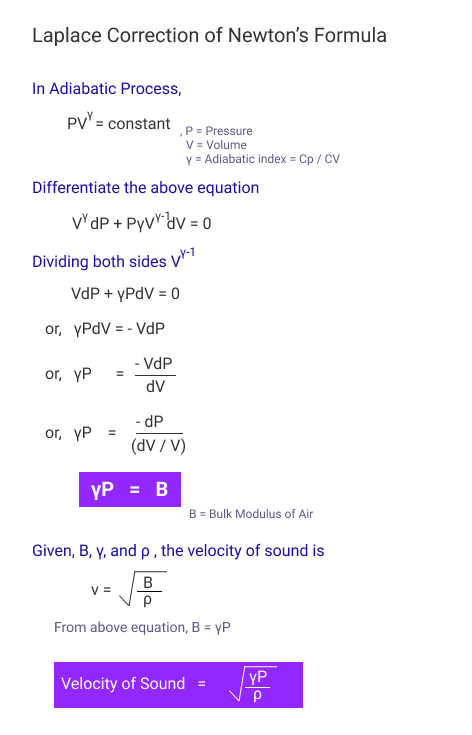Newton’s formula to calculate the velocity of sound in air is,
v = √(P / ρ )
Here,
- P = Pressure
- ρ = Density of air

According to Newton, when sound waves travel in the air, compression and rarefaction are formed. He also assumed that the process was very slow, and there was heat exchange during the process.
During the compression, the heat produced is given to the surroundings and the heat loss is gained from the surrounding. Hence, the temperature remains constant and sound waves propagate through an isothermal process.
Derivation: Newton’s Formula of Velocity of Sound in Air
According to Boyle’s law (law of gas), the pressure of the gas is inversely proportional to the volume.
P ∝ 1 / V
where,
- P = Pressure
- V = Volume of air
Hence,
P = constant / V
or, PV = constant
Now, let’s differentiate the above equation,
PdV + VdP = 0
or, PdV = -VdP
or, P = - (VdP / dV)
or, P = dP / - (dV / V)
or, P = B
where B is the bulk modulus of the air.
If we have B as the bulk modulus and ρ as the density of the air, then the velocity is given by
v = √(B / ρ )
From the earlier equation, we know that B = P. So, we get the velocity of sound in air as
v= √(P / ρ )

Calculation: Velocity of Sound using Newton’s Formula
At NTP (Normal Temperature and Pressure), we have
Pressure (P) = 1.1013 * 105 N/m2
Density of air(ρ) = 1.293 kg/m3
Now, we can calculate the velocity as
v = √(P / ρ )
= √(1.1013 * 105 / 1.293 )
v = 280 m / s
Flaws in Newton’s Formula
From the above calculation, we have calculated the velocity of sound as 280 m/s. However, experimentally it has been found that the velocity of sound in air is 332 m/s.
This concludes that there is some error in Netwon’s assumption and needs correction.
Laplace Correction of Newton’s Formula
Laplace Correction solves the error in Newton’s formula by providing an assumption.
According to Laplace, compression and rarefaction occur very fast and there is no heat exchange during the compression. Thus, the temperature doesn’t remain constant and the propagation of sound in the gas is an adiabatic process.
Derivation of Laplace Correction
In an Adiabatic Process,
PVγ = constant
Here,
- P = Pressure
- V = Volume
- γ = Adiabatic index = Cp / CV
- Cp = Specific heat for constant pressure
- CV = Specific heat for constant volume
Differentiating the above equation, we get
VγdP + PγVγ - 1dV = 0
Dividing both sides by Vγ – 1
VdP + γPdV = 0
or, γPdV = - VdP
or, γP = - VdP / dV
or, γP = - dP / (dV / V)
or, γP = B
where B is the bulk modulus of the air.
If we have B as the bulk modulus of the air, γ as the adiabatic index, and ρ as the density, then the velocity of sound is given as
v = √(B / ρ )
From the earlier equation, we know B = γP. Hence, Laplace Correction gives the velocity of sound in air as
v = √(γP / ρ )

Calculation: Velocity of Sound using Laplace Correction
At NTP (Normal Temperature and Pressure), we have
Pressure (P) = 1.1013 * 105 N/m2
Density of air (ρ) = 1.293 kg/m3
Adiabatic index (γ) = 1.4
Now, we can calculate the velocity as
v = √(γP / ρ )
= √ ( (1.4 * 1.1013 * 105) / 1.293)
v = 332 m/s2This value is very close to the experimental value. Hence, Laplace Correction provides the correction to Newton’s Formula to compute the velocity of sound in air.